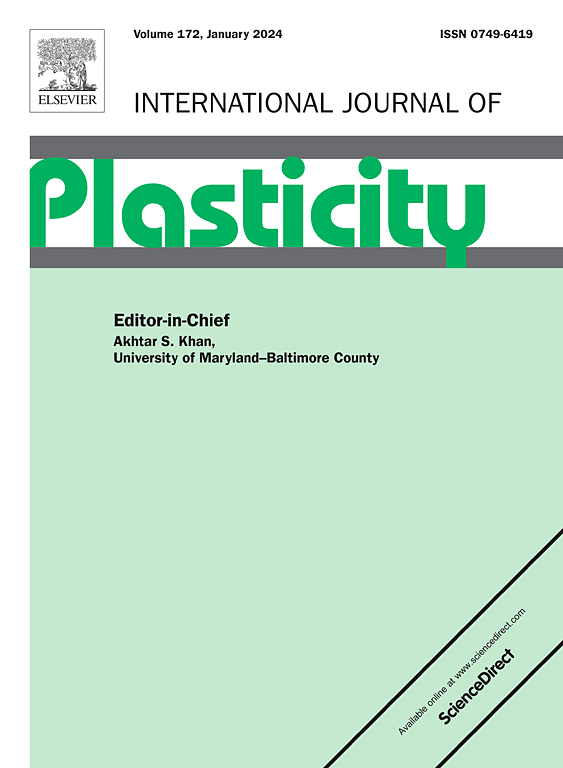Achieving high strength and ductility of titanium matrix composite reinforced with networked TiB via SPS sintering of core-shell powder and accumulative hot rolling
IF 9.4
1区 材料科学
Q1 ENGINEERING, MECHANICAL
引用次数: 0
Abstract
The enhancement of strength and ductility of titanium matrix composites (TMCs) is crucial for lightweighting and expanding their advanced engineering applications. However, it is still a challenge for TMCs to achieve ultrahigh tensile strength with suitable ductility. In this study, a special low-temperature accumulative hot rolling (AHR) process was proposed to regulate the grain/phase boundaries and dislocation structures of TMCs reinforced with networked TiB. Through the AHR process, we have achieved exceptionally tensile strength and yield strength of 1570 MPa and 1460 MPa, respectively, accompanied with a suitable ductility of ∼7.5%. During the AHRed process, the majority of α-Ti grains rotated towards the favorable orientations, which display high SFs for basal slip in ND and prismatic slip in RD, respectively, resulting in the formation of {0002} texture. The accumulation and recovery of dislocations led to the formation of high-density sub-grain boundaries and geometrically necessary dislocations (GNDs) within α-Ti grains. Specifically, the GNDs rose dramatically from 1.06 × 1014 m−2 to 8.16 × 1014 m−2, whereas the size of α-Ti grains decreased significantly from 6.8 to 1.1 μm. In the β phase grains, secondary phase transformation was induced via the AHR process, resulting in the introduction of high-density nano-scaled secondary α-Ti lamellae (∼4 nm) with a fully coherent interface {110}BCC//{0002}HCP. After the AHR process, the crack nucleation and prolongation along the networked TiB was inhibited, resulting in the enhancement of ductility. This special AHR strategy, combining grain/hetero-phase boundary engineering and dislocation engineering, has great potential and universality for designing TMCs with both ultrahigh strength and suitable ductility.通过核壳粉末的 SPS 烧结和累积热轧实现网络化 TiB 增强钛基复合材料的高强度和延展性
提高钛基复合材料(TMC)的强度和延展性对于轻量化和扩大其先进工程应用至关重要。然而,钛基复合材料要达到超高拉伸强度和适当的延展性仍是一项挑战。在这项研究中,我们提出了一种特殊的低温累积热轧(AHR)工艺来调节用网络化 TiB 增强的 TMC 的晶粒/相界和位错结构。通过 AHR 工艺,我们获得了超常的抗拉强度和屈服强度,分别为 1570 兆帕和 1460 兆帕,同时还获得了 ∼7.5% 的适当延展性。在 AHRed 过程中,大部分 α-Ti 晶粒向有利取向旋转,在 ND 中显示出较高的基底滑移 SFs,在 RD 中显示出较高的棱柱滑移 SFs,从而形成了 {0002} 纹理。位错的积累和恢复导致在α-钛晶粒内形成了高密度的亚晶界和几何必要位错(GNDs)。具体来说,GNDs 从 1.06 × 1014 m-2 显著上升到 8.16 × 1014 m-2,而 α-Ti 晶粒的尺寸则从 6.8 μm 显著下降到 1.1 μm。在 β 相晶粒中,通过 AHR 过程诱导了二次相变,从而引入了高密度纳米级二次α-钛薄片(∼4 nm),其界面为完全相干的{110}BCC//{0002}HCP。经过 AHR 处理后,沿网络状 TiB 的裂纹成核和扩展受到抑制,从而提高了延展性。这种结合了晶粒/异相边界工程和位错工程的特殊 AHR 策略在设计具有超高强度和适当延展性的 TMC 方面具有巨大的潜力和普遍性。
本文章由计算机程序翻译,如有差异,请以英文原文为准。
求助全文
约1分钟内获得全文
求助全文
来源期刊

International Journal of Plasticity
工程技术-材料科学:综合
CiteScore
15.30
自引率
26.50%
发文量
256
审稿时长
46 days
期刊介绍:
International Journal of Plasticity aims to present original research encompassing all facets of plastic deformation, damage, and fracture behavior in both isotropic and anisotropic solids. This includes exploring the thermodynamics of plasticity and fracture, continuum theory, and macroscopic as well as microscopic phenomena.
Topics of interest span the plastic behavior of single crystals and polycrystalline metals, ceramics, rocks, soils, composites, nanocrystalline and microelectronics materials, shape memory alloys, ferroelectric ceramics, thin films, and polymers. Additionally, the journal covers plasticity aspects of failure and fracture mechanics. Contributions involving significant experimental, numerical, or theoretical advancements that enhance the understanding of the plastic behavior of solids are particularly valued. Papers addressing the modeling of finite nonlinear elastic deformation, bearing similarities to the modeling of plastic deformation, are also welcomed.
 求助内容:
求助内容: 应助结果提醒方式:
应助结果提醒方式:


